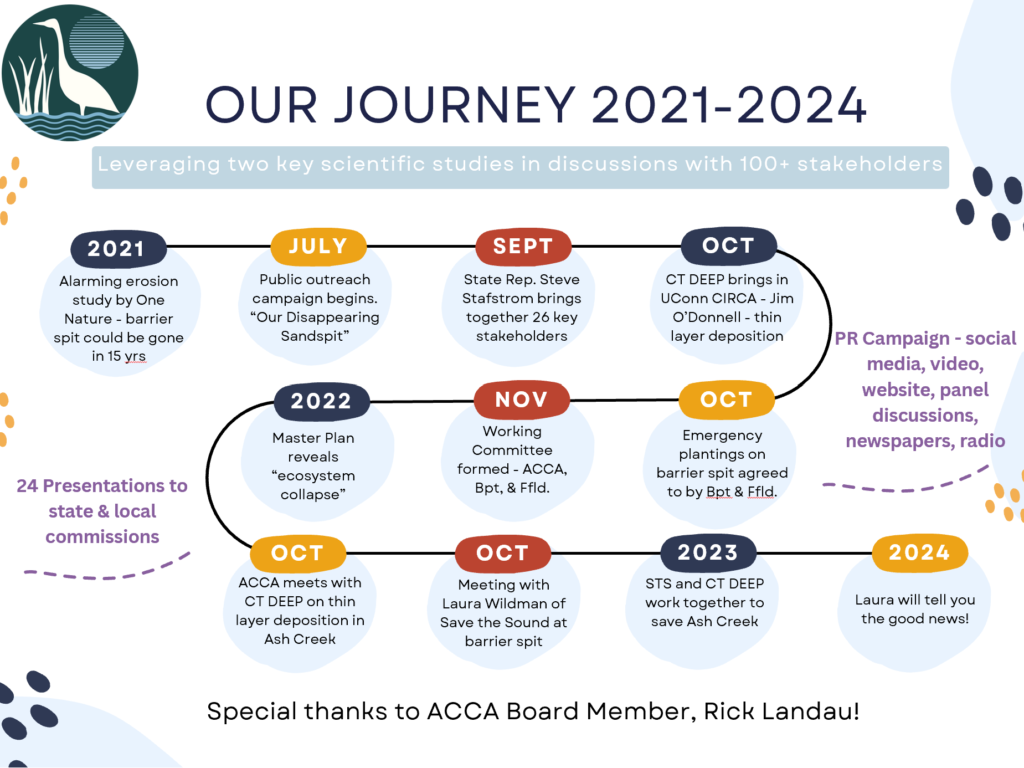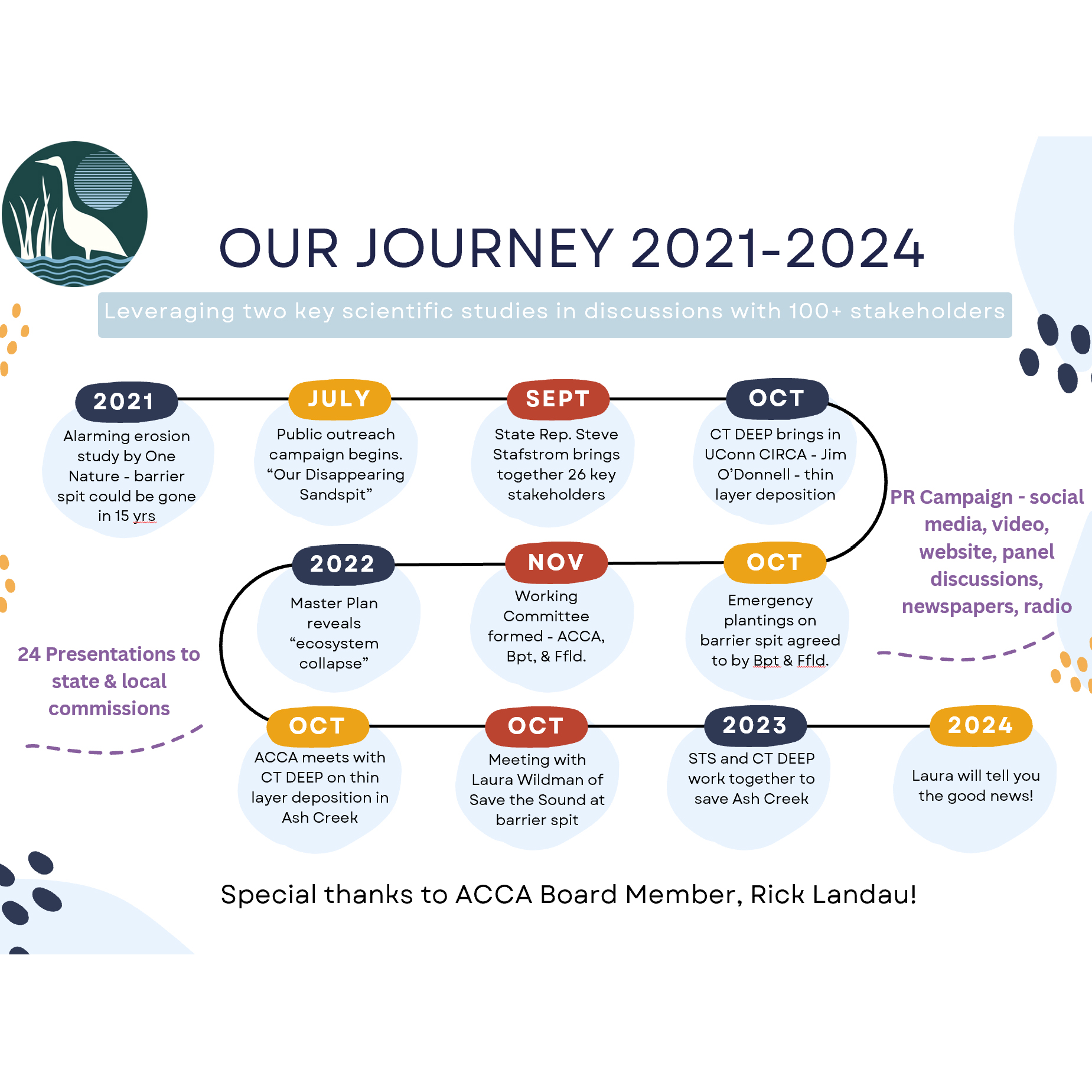Our journey began in March 2021 with the first scientific study which we commissioned to understand the extent of the erosion in Ash Creek after a particularly drastic dredging operation in the channel to the marina that affected the barrier spit. We hired One Nature, the ecological scientists who had developed our Master Plan of Conservation for Ash Creek ten years before. They concluded that the barrier spit could be underwater within 15 years, if current erosion trends continued.
If a Category 3 hurricane came through, we could lose it overnight in one storm. Did you know that we haven’t had a Category 3 hurricane since Hurricane Carol? The return rate on Category 3 hurricanes along our coastline is 75 years. That means we are due any time now for one!
Our scientists also noticed changes to Great Marsh Island. They found that the island had lost about 25,000 SF of intertidal marsh land over a 29 year period from 1991 to 2020. Our scientists confirmed that once the barrier spit is lost, Great Marsh Island will be destroyed by wave action soon after.
We mapped out a public relations campaign to bring awareness about this issue to the attention of policymakers. The best way to do that is to get the public involved and in communication with policymakers. Some of you may remember our presentation at the Fayerweather Yacht Club in July of 2021, which we called, “Our Disappearing Sandspit”. Your emails and phone calls to our legislators had an impact!
Rick Landau and Gail Robinson of ACCA’s Board of Directors hit the road with this presentation and went before every commission in Bridgeport and Fairfield as well as MetroCOG at the regional level. We gave over a dozen presentations and participated in countless Zoom meetings and phone calls.
Jon Fatigate volunteered his time to create a dedicated website for us called “Save Our Spit” and a video starring ACCA Board member, Donna Curran. A professional photographer, Barry Hyman, who is here tonight, created dramatic drone flyover videos of Ash Creek.
We also had featured articles in the newspaper, interviews on radio talk shows, and a social media campaign. Check out our Facebook and Instagram pages (see links at bottom) and follow them!
In September of 2021, State Rep. Steve Stafstrom pulled together a Zoom meeting with 26 policymakers and government officials from local and state levels to help them understand the issues we faced with erosion in Ash Creek and plan next steps. We had officials from Bridgeport, Fairfield, and CT DEEP in attendance.
This meeting led to our next one with CT DEEP and CIRCA. CIRCA is part of UConn, but its research on sea level rise is used in policy decision making. Jim O’Donnell is the top researcher and Executive Director of CIRCA.
In October of 2021, we had a small Zoom meeting with the Director of CT DEEP’s Land and Water division, Brian Thompson, and Jim O’Donnell of CIRCA in which thin layer deposition was raised as an option. Thin layer deposition is a living shoreline technique for building up wetlands affected by erosion. It involves depositing a thin layer of sand on the wetlands. The plants climb above the sand if done right. Of course things can go wrong. Too little sand and the erosion continues, too much sand and the plants die. Nonetheless, it is a technique often used in South Carolina, but only experimentally along the Connecticut shoreline. They all agreed that this would require expensive studies before the technique could be considered for Ash Creek and a nearby source of sand, perhaps from dredging operations.
By October of 2021, we had held many meetings with Fairfield and Bridgeport. One of the recommendations from our first scientific study was to plant American beach grass on the barrier spit to protect it from further erosion and help capture sand to begin building a dune again. This was a forty thousand dollar project and ACCA brokered a deal between the two municipalities to split the costs.
The emergency grass planting project led to the creation of a Working Committee between Fairfield, Bridgeport and ACCA, which continues to this day and includes Tim Bishop, the Conservation Director of Fairfield and Chadwick Schroeder, the head of Sustainability for Bridgeport, along with Rick and Gail.
We had commissioned One Nature to revise our Master Plan of Conservation for Ash Creek since the first one had not taken into account sea level rise and climate change. The revised Master Plan shocked us with the news that our tidal estuary was in the beginning stages of what is called “ecosystem collapse.” This means it was in the process of losing all its tidal wetlands by the end of the century.
Rick and I took to the road again in 2022, and gave presentations to all the local commissions. Gail served on two panels on climate change hosted by State Senator Tony Hwang to spread the word about Ash Creek’s dire situation. Jim O’Donnell of CIRCA was on those same panels. Networking was crucial to keeping the conversations alive with CIRCA and CT DEEP on solutions for our tidal estuary.
All our hard work finally resulted in a step forward in October of 2022, when we had a Zoom meeting with two of the top people at CT DEEP who said they would consider the thin layer deposition technique for Ash Creek if the proper studies were conducted.
We knew our small grassroots organization could not manage a project of this magnitude and we had been searching for some time for the right strategic partner who could go after the funding and manage the project.
One of the most desirable potential partners was Save the Sound, but we couldn’t get their attention until a new head of the Restoration division was hired.
As luck would have it, we were finally able to meet with the new head of the Restoration division, an engineer named Laura Wildman, at the barrier spit the week after our meeting with CT DEEP. We explained the problems of Ash Creek and she said this would be an ideal site for a technique called thin layer deposition, but its too bad CT DEEP doesn’t allow that technique in Connecticut. We told her that we had laid the groundwork for CT DEEP to consider it for Ash Creek. She got very excited. We got very excited.
Save the Sound got in touch with CT DEEP, who told her they were interested in the project and would find funding for it. This led to the initial $600,000 and hopefully the next $400,000, which will provide the funding for the planning stage of the restoration of Ash Creek.



